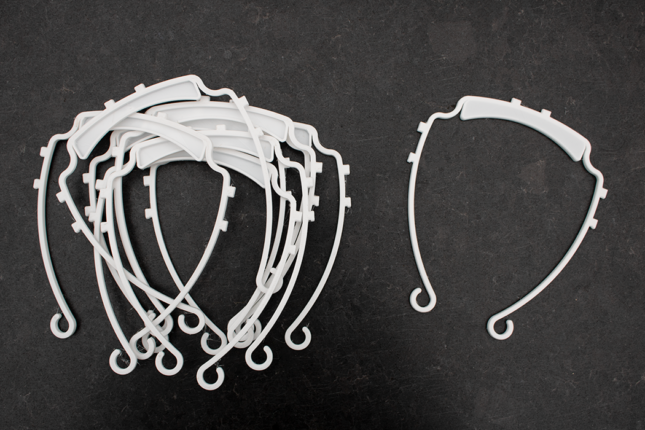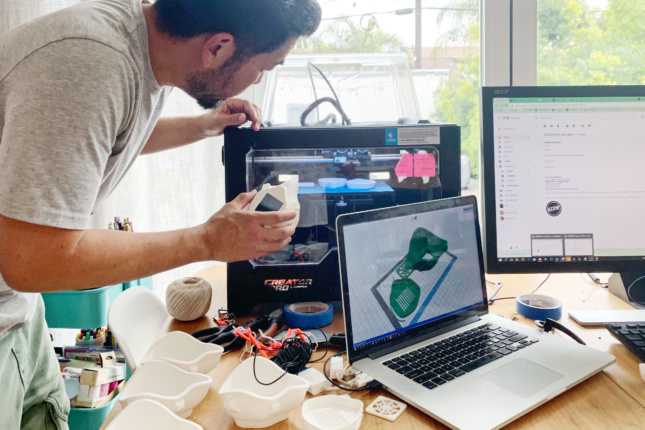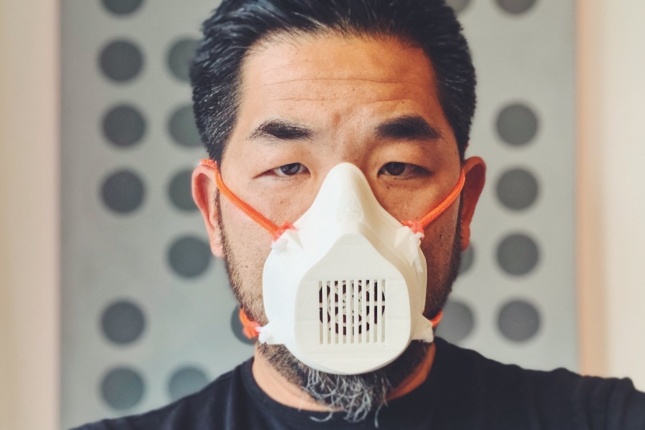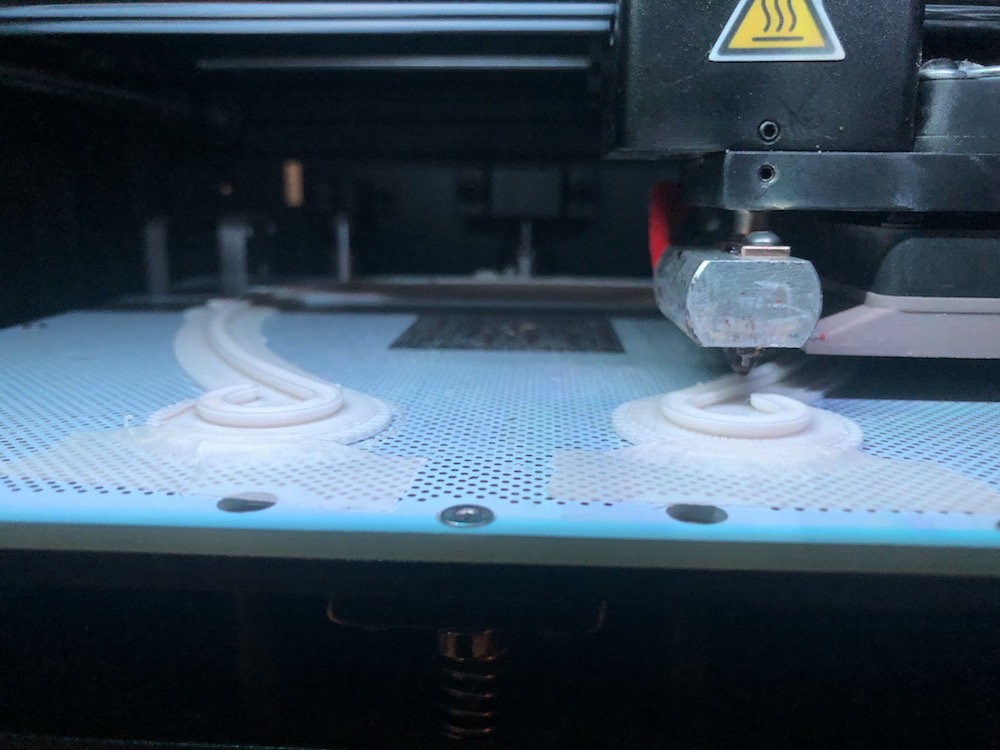Things right now are undoubtedly, brutally rough. And when the going gets rough, the architecture and design community gets 3D printing.
As part of a sweeping grassroots mobilization effort that expands and evolves daily, architects, designers, makers, and a small army of displaced students have banded together and fired up their 3D printers to produce the personal protective equipment (PPE) so desperately needed in hospitals that are struggling to provide necessary gear to the doctors, nurses, and other medical professionals on the front lines of the COVID-19 pandemic.
“This is, without question, the worst public health crisis of our lifetime. The numbers are truly staggering, and for medical professionals, it is very much like a war, causing casualties and death,” said Dr. James Pacholka MD, a surgeon at Southern Ohio Medical Center, in a statement shared with AN. “No one wants to fight a battle without adequate protection and the PPE’s are our armor, so any help we get in that regard is incredible. And for people using their expertise to help us in any way that they can is honestly beautiful, and serves as a warm reminder of mankind’s goodness and generosity.”
In that regard, the architecture and design community has more than risen to the occasion.
The Operation PPE effort began in earnest with an SOS of sorts sent via email late on March 24 by Kirstin Petersen, assistant professor at Cornell University’s School of Electrical and Computer Engineering to fellow professor Jenny Sabin, director of Sabin Lab at Cornell’s College of Architecture, Art, and Planning (AAP) and principal of the eponymous architectural design studio based in Ithaca, New York.
Petersen relayed the dire need for PPE (personal protective equipment), specifically face shields, at Weill Cornell Medicine, the university’s medical school and biomedical research unit in New York City. The request—initially estimated by Weill Cornell to be 20,000 to 50,000 per day in New York City—rapidly disseminated throughout multiple departments at the university. By 10:00 a.m. the next morning, Sabin, with the blessing of Meejin Yoon, dean of Cornell AAP, had reopened the school’s Digital Fabrication Lab, fired up all 10 of its 3D printers, and got to work.

At the same time, Sabin spread the word to faculty, staff, and students while providing detailed instructions on the lab website. Petersen and Amy Kuceyeski, associate professor of mathematics at Weill Cornell Medicine’s Feil Family Brain and Mind Research Institute, also started a Slack channel to keep lines of communication open and flowing in a single dedicated space.
“We were able to respond to the need right away,” Sabin explained to AN. “And what started out as just a few labs on Cornell’s campus then began to grow.”
Sabin and others that have since joined the Operation PPE movement are basing their output, which includes a laser-cut clear plastic shield alongside a 3D-printed visor band that snugly fits across a user’s forehead, on an open-source design file created by Erik Cederberg of Swedish company 3D Verkstan. That design, and that design only without any major modifications, has been verified for use by Weill Cornell. The shields, which can be discarded or sanitized and reused, are made from polyethylene sheets while the visor band component is generally made from PLA or ABS, both standard 3D printing materials. PET or PETG, however, is preferred by the medical community as it’s safer to reuse and longer-lasting. Once the components are distributed, hospital staff sanitizes and assembles the face shields.
Ultimately, 3D-printed PPE is meant as a temporary solution, as desperate times call for creative measures. But as far as stopgap measures go at least one medical professional, an emergency room doctor at a major New York City Hospital, gave his approval: “The 3D shields and masks being made may be very useful, and can be designed with comfort, visibility, and re-usability in mind,” he said in a statement provided to AN.

A ground-up, grassroots movement grows
While Sabin’s Digital Fabrication Lab and other labs within Cornell departments that have access to 3D printers and laser cutters quickly got to work (all with an eye toward social distancing and overall safety), Yoon sent out an all-hands-on-deck email to the school’s vast network of alumni. Within 48 hours of Petersen reaching out to Sabin, a slew of major architecture firms—Terreform, Grimshaw, Bjarke Ingels Group, Handel Associates, Weiss Manfredi, and Kohn Pedersen Fox among them—had joined the effort.
Edg Architecture, a mid-sized Manhattan-based architecture and engineering firm, also sprung into action. Notably, edg made a slight but critical adjustment to the visor band allowing for a tighter and more protective fit that also enabled production to increase by up to 20 percent. Currently, edg is producing up to 100 face shields per day and plans to launch a website to connect and coordinate those looking to pitch in.
“In less than four days we had this massive web of people firing up their machines, dedicating material, and donating their time and effort,” remarked Sabin. As of this writing, Cornell’s on-campus labs have donated 5,800 face shields, a number that jumps significantly when also including PPE made and donated by alumni architects and their networks.
“Together and in a very short amount of time, we were able to respond to a gap within the supply chain by leveraging 3D printing and a network of digital fabrication labs. On one hand, 3D printing is not the best way to make these parts, and one 3D printer isn’t going to make an impact, but when you have thousands… it’s incredible.”
Students and faculty from schools including Parsons, the University of Southern California, Carnegie Mellon, and Iowa State have since joined Operation PPE. “The power of people coming together is just amazing,” said Sabin.
Mitch McEwen, assistant professor at the Princeton School of Architecture and founding director of Black Box Research Group, has also played an active early role on the design and organizational fronts. As noted by McEwen, one area of focus for the team has been on the material supply chain. “How do you widen the stream of materials coming into this, and how do we get ahead of the curve on the next PPE disaster?” she said, adding that the Department of Health and Human Services has mentioned a potential shortage of PPE gowns is on the horizon. “PPE shortages have been cannibalizing the materials they already have.”

Expanding the network
Cornell AAP alumnus Jay Valgora, founder of multidisciplinary design firm STUDIO V, was among the first architects to enlist in Operation PPE and has been instrumental in helping get the word out wide and far. (His son, Jesse, an architecture student at Syracuse University, is also involved in the fabrication and material-sourcing efforts.)
“Everyone wants to help and no one knows what to do,” Valgora told AN. “So it’s kind of great to not only do this—to get this equipment into the hands of medical workers who really need it—but it’s also great to give people a vehicle where they can help out and play a positive role.”
Noting that his staff is now working from home remotely, Valgora said: “I can still go into the studio, which is empty now, so I went in there with Jesse and we dragged our 3D printers out and brought them home and set them up in our loft and started to print around the clock.”
In addition to printing away alongside Jesse at his makeshift home lab, Valgora is teaming with Illya Azaroff, president-elect of AIA New York State, to help consolidate the growing number of different grassroots factions that have joined Operation PPE throughout the state. “We’re trying to create a larger movement to get more people involved,” said Valgora of his team-up with the AIA. “It would be great if the next step were to be to take this national.”
While Valgora collaborates with AIA New York State to bolster outreach and involvement within the architecture community, the New York City Economic Development Corporation (NYCEDC), acting as a clearinghouse, has also launched a formal intake process to better coordinate with local businesses looking to make and donate crucial medical supplies. The donations will be vetted by the Department of Health to ensure they meet safety protocols, at the scale needed for the city’s COVID-19 response. The NYCEDC has received over 1,700 queries from interested businesses in just several days
Per Shavone Williams, vice president and chief of staff for public affairs at the NYCEDC, the businesses working directly with the city to produce PPE include Makerspace NYC, Adafruit, and Brooklyn-based custom fabrication company Bednark Studios. Between these three enterprises, 127,000 face shield kits were delivered to New York hospitals this past week.

The effort out West
In Southern California, similar PPE-producing efforts are underway including one directly inspired by Sabin Lab’s call to arms that’s spearheaded by Alvin Huang, an associate professor at the USC School of Architecture and founding principal of Synthesis Design + Architecture.
Since putting out an open call week, Huang has brought together an initial network north of 80 people—largely USC faculty, alumni, and friends—working with 100 3D printers and three laser cutters. Students from other Los Angeles-area schools including SCI-arc and Santa Monica College have also joined the local effort as have firms including KAA Associates, ARUP, CO Architects, Michael Maltzan Architects, RCH Studios, Brooks Scarpa, and others. The gear produced by the Huang-launched campaign is being distributed to, via pickups coordinated by USC’s Keck Medicine, to LAC+USC Medical Center, Keck Hospital, Children’s Hospital Los Angeles, and MLK Willowbrook Hospital.

“I’m proud to announce we’re mobilizing our architecture, design, and manufacturing communities to utilize 3D-printing technologies,” said Los Angeles Mayor Eric Garcetti at daily press briefing held earlier this week in which he discussed the city’s larger L.A. Protects initiative. “We’re getting this done by tapping into resources in our own backyard—developing prototypes and designs with USC’s architecture, engineering, and medical schools. We’re working with UCLA and other local universities, design schools, and architecture firms to utilize their materials and to use their expertise.”
Like the effort originating at Cornell, Huang’s bourgeoning L.A.-centered network is creating and distributing protective face shields using a new design from Budman that’s been approved by Keck. The primary focus, however, is on producing 3D-printed “pseudo N95 masks,” which are also verified by Keck. N95 masks, which as others involved with the Operation PPE effort have pointed out, are not being produced at the same scale as face shield kits because 3D printers simply cannot replicate their complex design in a way that meets medical standards.

“We brought this to the attention of Keck as we were concerned that we might be leading people to think they are safe when they’re not,” Huang told AN. “Keck said they were fully aware and had tested everything […] they said these masks were not what they are using now, and they’re not a replacement for medical-grade PPE. They’re backups to the backup.”
“This might be the scariest thing I’ve heard,” admitted Huang. “But Keck’s response was that this is wartime medicine, and we’re preparing for war, and in wars you need a backup to the backup. And Keck identified this as a backup that’s one level above using homemade cloth masks, bandanas, and socks.”
It’s a grim assessment, for sure, but these are extraordinary times.
As for Sabin, she’s looking past the bleakness and focusing on the synergetic, humane work being done by a community united by one common objective.
“For me, the important thing to get out there is the network of people that have come together. The bridge, in terms of working across disciplines, has very much been the context of emerging technology, especially in digital fabrication and 3D printing,” she said. “There’s a kind of democratic space in that it is informal and bottom-up, and we’ve been able to make a real impact in that way. I think everybody’s been looking for a way to contribute during this difficult and unprecedented time, and I think this is a real and positive way to come together even though we can’t be near each other physically. And every visor, every shield, makes a difference.”
For those without a 3D printer or digital fabrication skills, please see #GetUsPPE to explore other ways in which you can help.
